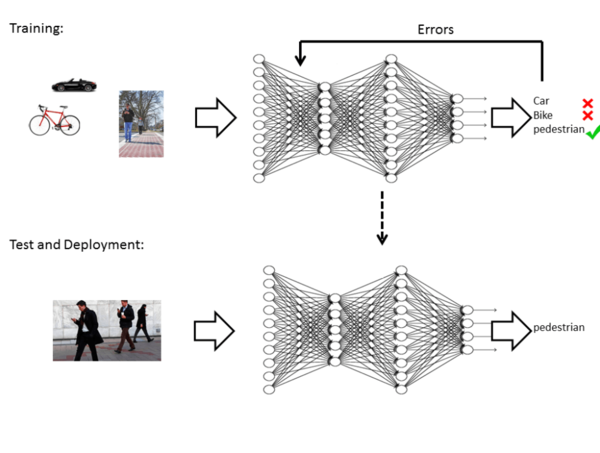Technologies leveraged from advanced computing in data centers are opening up new ways to tackle defense missions across embedded platforms. Deep learning is an increasingly popular approach to processing very large data sets. Many high-visibility projects involved with image processing and data mining use deep learning techniques to predict and evaluate future events and courses of action. The US Department of Homeland Security’s Synthetic Environment for Analysis and Simulations (SEAS) project for example is currently using the SEAS that was developed by Purdue University to predict and evaluate future events and courses of action. While deep learning methodologies are not exactly new, the processing power needed for such complex applications is finally becoming miniaturized and low-power enough for packaging into embedded computing systems.
hpec up for deep learning challenges
Deep learning applications can utilize technologies such as high-speed switched serial links, rugged standardized form factors, and HPEC (High-Performance Embedded Computing) middleware. These technologies have been developed and honed over the years to address HPEC problems such as synthetic aperture radar (SAR) and military signal intelligence (SIGINT) applications. The challenge for the system integrator, therefore, is to define how deep learning algorithms can be applied to solve their particular problem.

Above is an example of how deep learning works on an embedded HPEC system. Requiring a huge amount of computation in the testing phase, a snapshot of the network is taken with each training result and tested. This process is repeated with the expectation that the next snapshot will respond better than the previous one.
As defense system use evolves in providing greater application autonomy, and as deep learning techniques tend to be most useful for pattern recognition tasks such as natural language processing and image feature detection, it makes sense that deep learning could be successfully applied for on-platform processing of streaming signal or image data. These systems would have the power to sift through voluminous streams of data looking for either signals or targets of interest.
The strategic role of deep learning
It is possible to build modular HPEC systems optimized for deep learning applications with readily available platforms based on the Intel® Xeon® Processor D-1540 (Broadwell DE). Stimulated by today’s leading-edge and powerful HPEC platforms such as Kontron’s StarVX, deep learning applications can play a strategic role in advancing future military operations.
Facilitating deep learning for military applications - webinar on december, 6th
Join our webinar on December, 6th, at 11:00 AM EST, and find out more about how Kontron’s advanced HPEC platforms facilitate on-platform processing of streaming signal or image data for deep learning applications. Kontron industry experts, Mark Littlefield, Vertical Product Manager, Defense, Kontron and Dr. Mohamed Bergach, System/Software Architect, will discuss:
-
How HPEC can be applied to deep learning algorithms to solve military application problems such as synthetic aperture radar (SAR) and signal intelligence (SIGINT) applications.
-
Platforms that easily sift through huge data streams from the military’s large signal and image processing systems with the newest Intel processors.
-
Kontron’s StarVX HPEC system packs server-class silicon and highly ruggedized technologies in a compact 3U blade footprint to provide a deployable platform for deep learning or other HPEC applications.
To register for this informative webinar, please click here.

{{comment.comment}}